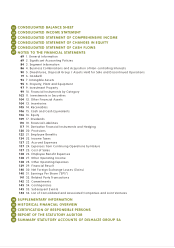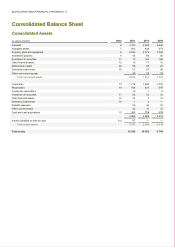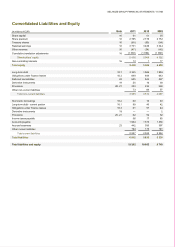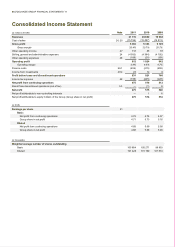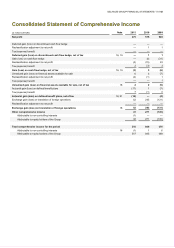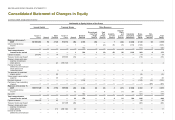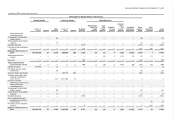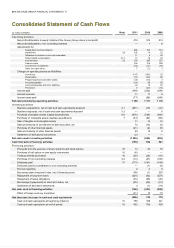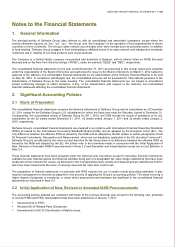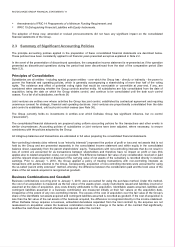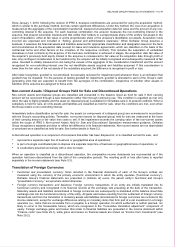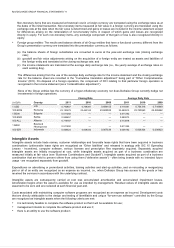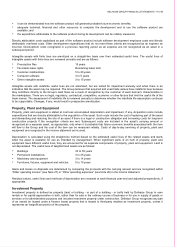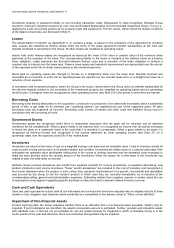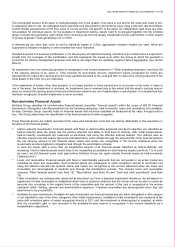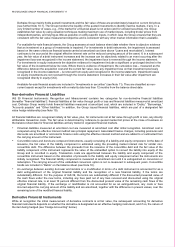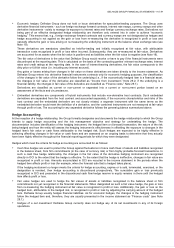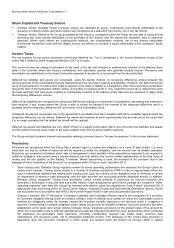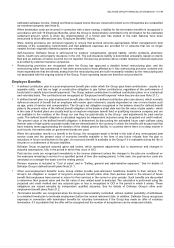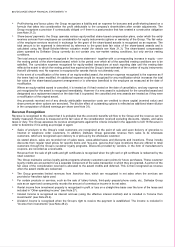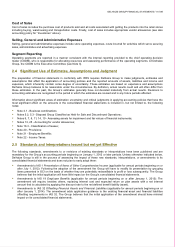Food Lion 2011 Annual Report Download - page 73
Download and view the complete annual report
Please find page 73 of the 2011 Food Lion annual report below. You can navigate through the pages in the report by either clicking on the pages listed below, or by using the keyword search tool below to find specific information within the annual report.
DELHAIZE GROUP FINANCIAL STATEMENTS ’11 // 71
Since January 1, 2010, following the revision of IFRS 3, business combinations are accounted for using the acquisition method,
which is similar to the purchase method, but has certain significant differences. Under this method, the cost of an acquisition is
measured as the aggregate of the consideration transferred, measured at acquisition date fair value and the amount of any non-
controlling interest in the acquiree. For each business combination, the acquirer measures the non-controlling interest in the
acquiree, that present ownership interests and that entitle their holders to a proportionate share of the entity's net assets in the
event of liquidation, either at fair value or at the proportionate share of the acquiree’s identifiable net assets. Acquisition costs
incurred are expensed and included in “Selling, general and administrative expenses.” When Delhaize Group acquires a
business, it assesses the financial assets and liabilities assumed for appropriate classification and designation based on the facts
and circumstances at the acquisition date (except for lease and insurance agreements, which are classified on the basis of the
contractual terms and other factors at the inception of the respective contract). This includes the separation of embedded
derivatives in host contracts by the acquiree. If the business combination is achieved in stages, the acquisition date fair value of
the acquirer’s previously held equity interest in the acquiree is remeasured to fair value at the acquisition date through profit or
loss. Any contingent consideration to be transferred by the acquirer will be initially recognised and subsequently measured at fair
value. Goodwill is initially measured at cost being the excess of the aggregate of the consideration transferred and the amount
recognised for non-controlling interest over the net identifiable assets acquired and liabilities assumed. If this consideration is
lower than the fair value of the net assets of the subsidiary acquired, the difference is recognised in profit or loss.
After initial recognition, goodwill is not amortized, but annually reviewed for impairment and whenever there is an indication that
goodwill may be impaired. For the purpose of testing goodwill for impairment, goodwill is allocated to each of the Group’s cash
generating units that are expected to benefit from the synergies of the combination, irrespective of whether other assets or
liabilities of the acquiree are assigned to those units.
Non-current Assets / Disposal Groups Held for Sale and Discontinued Operations
Non-current assets and disposal groups are classified and presented in the balance sheet as held for sale if their carrying
amount will be recovered through a sale transaction rather than through continuing use. This condition is regarded as met only
when the sale is highly probable and the asset (or disposal group) is available for immediate sale in its present condition. When a
subsidiary is held for sale, all of its assets and liabilities are classified as held for sale, when the conditions are met, even when
the Group retains a non-controlling interest.
Immediately before classification as held for sale, the assets (or components of a disposal group) are re-measured in accordance
with the Group’s accounting policies. Thereafter, non-current assets (or disposal group) held for sale are measured at the lower
of their carrying amount or fair value less costs to sell. If the impairment exceeds the carrying value of the non-current assets
within the scope of IFRS 5 Non-current Assets Held for Sale and Discontinued Operations measurement guidance, Delhaize
Group recognizes a separate provision to reflect the difference in its financial statements. Non-current assets are not depreciated
or amortized once classified as held for sale. See further details in Note 5.2.
A discontinued operation is a component of a business that either has been disposed of, or is classified as held for sale, and:
• represents a separate major line of business or geographical area of operations;
• is part of a single coordinated plan to dispose of a separate major line of business or geographical area of operations; or
• is a subsidiary acquired exclusively with a view to resale.
When an operation is classified as a discontinued operation, the comparative income statements are re-presented as if the
operation had been discontinued from the start of the comparative periods. The resulting profit or loss after taxes is reported
separately in the income statements (see Note 5.3).
Translation of Foreign Currencies
• Functional and presentation currency: Items included in the financial statements of each of the Group’s entities are
measured using the currency of the primary economic environment in which the entity operates (“functional currency”).
Delhaize Group’s financial statements are presented in (millions of) euros, the parent entity’s functional and Group’s
“presentation currency,” except where stated otherwise.
• Foreign currency transactions and balances: Foreign currency transactions of an entity are initially translated into its
functional currency and recognized in its financial records at the exchange rate prevailing at the date of the transaction.
Monetary assets and liabilities denominated in foreign currencies are subsequently re-translated at the balance sheet date
exchange rate into the functional currency of the entity. All gains and losses resulting from the settlement of foreign currency
transactions and from the translation of monetary assets and liabilities denominated in foreign currencies are included in the
income statement, except for exchange differences arising on monetary items that form part of a net investment in a foreign
operation (i.e., items that are receivable from or payable to a foreign operation, for which settlement is neither planned, nor
likely to occur in the foreseeable future), which are recognized in the “Cumulative translation adjustment” component of
equity. Foreign exchange gains and losses that relate to financial liabilities are presented in the income statement within
“Finance costs” (see Note 29.1), while gains and losses on financial assets are shown as “Income from investments” (see
Note 29.2).


